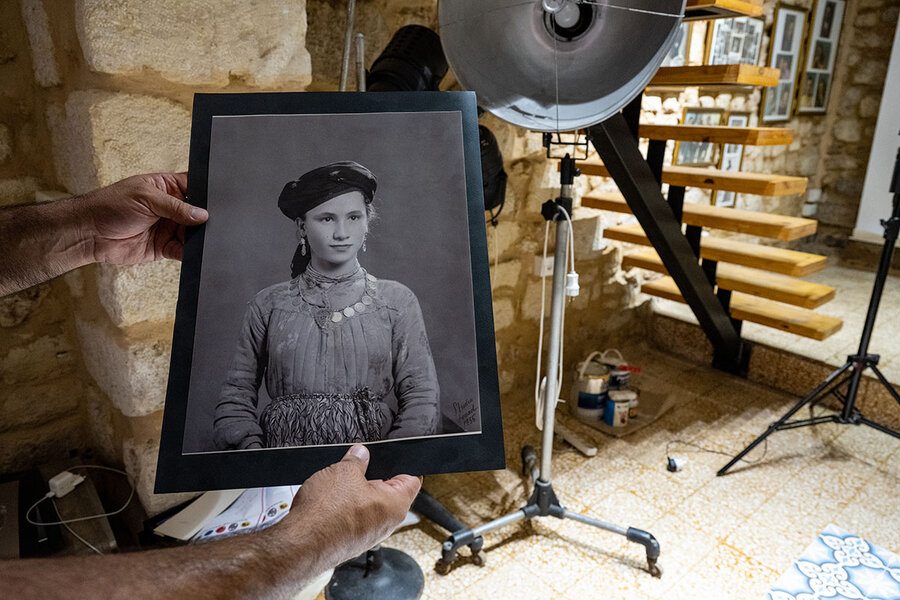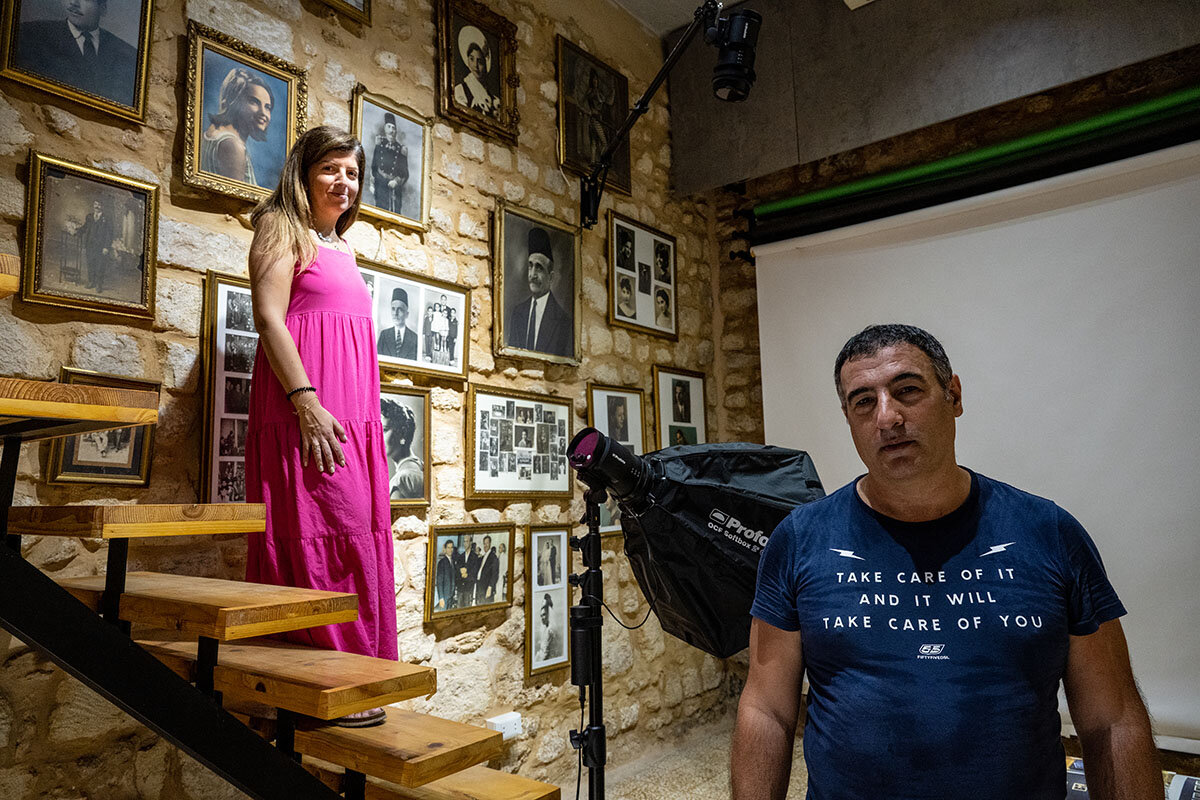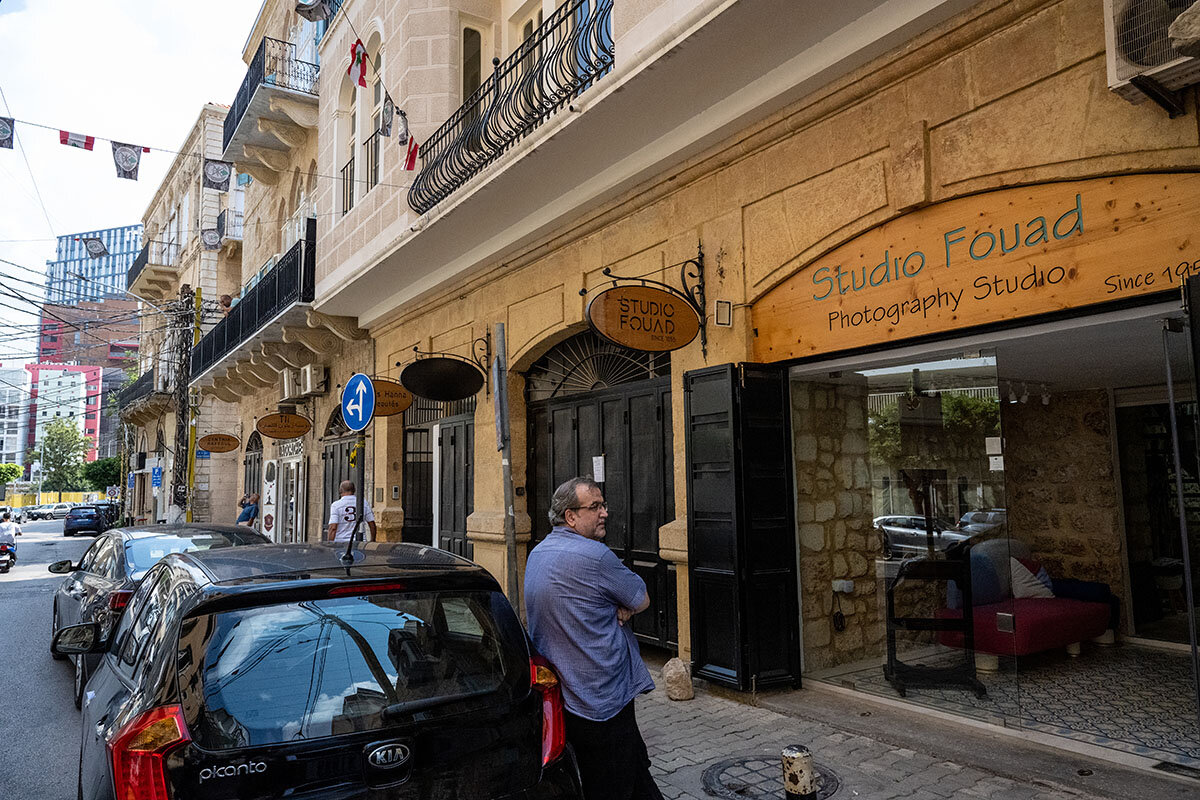After Beirut blast, community brings historic photo studio back to life
Loading...
| Beirut
The old photo studio’s trove of black-and-white negatives from the 1950s, wrapped carefully in paper and labeled in Arabic, is remarkable not only because of the bygone era it portrays but also because it survived the August 2020 blast at the nearby Port of Beirut.
That explosion left 300,000 people homeless, did $15 billion worth of damage, and turned Studio Fouad and many businesses on its street into piles of rubble.
Why We Wrote This
A story focused onIf the cataclysmic 2020 explosion in Beirut’s port symbolized government neglect, the community’s rebirth has been a story of cooperation and generosity. One beneficiary: a tiny photo studio with its precious images of a bygone era.
Bitterness over government neglect that is blamed for the blast and continues today is evident in graffiti that blankets walls and traffic barriers nearby. But Studio Fouad and its neighborhood have experienced an extraordinary rebirth, thanks to the generous support of fellow Lebanese determined to rebuild, among them a supermarket chain, several nongovernmental organizations, and even foreign donors.
Today photographer Bandali Gharabi displays the studio’s precious archives in the same hole-in-the-wall location where his father opened the business in 1955. And he expresses deep gratitude for the outpouring of help that rescued the studio – the oldest in Lebanon – when his solo attempts could not.
“We were very surprised,” says Mr. Gharabi of the scale of that revitalizing aid. “We were dead, and they made us alive again.”
Lebanese photographer Bandali Gharabi takes hold of the round, old-style, archive film canister – its thick cardboard darkened by dust and the passing of decades – as carefully as if he were holding an ancient clay jar of Dead Sea Scrolls.
As he pries the lid off, revealing a trove of black-and-white negatives from the 1950s, rolled and wrapped carefully in paper and labeled in Arabic, Mr. Gharabi is opening a historical time capsule.
The images are remarkable not only because of what they portray but also because they survived the epic August 2020 blast at the nearby Port of Beirut. That accidental ignition of a stockpile of ammonium nitrate – the second-largest nonnuclear explosion ever recorded – left more than 200 people dead and 300,000 homeless, and did $15 billion worth of damage.
Why We Wrote This
A story focused onIf the cataclysmic 2020 explosion in Beirut’s port symbolized government neglect, the community’s rebirth has been a story of cooperation and generosity. One beneficiary: a tiny photo studio with its precious images of a bygone era.
Amid the rubble was Mr. Gharabi’s photo studio, along with many of the businesses on this street in Beirut’s upmarket Gemmayzeh district.
Yet miraculously preserved between two walls of the former darkroom were the hundreds of thousands of archived images, taken and meticulously cared for by Mr. Gharabi’s father, Adib (who went by the nickname Fouad), ever since he opened Studio Fouad in 1955 and turned it into a Beirut institution.
Those archives – countless boxes and round canisters, rich with negatives that record weddings, portraits of school classes, and all manner of Lebanese lives from a bygone era – are all that remained from the blast that wrecked every camera in the shop, and for a time ruined Mr. Gharabi’s life.
Deep gratitude
He displays the precious archives today in a revamped studio, in the same hole-in-the-wall location his father first founded. And he expresses deep gratitude for the outpouring of help from local rebuilding organizations and the community effort that rescued the photo studio – the oldest in Lebanon – when his solo attempts could not.
“We were very surprised: We were dead, and they made us alive again,” says Mr. Gharabi of the scale of that revitalizing aid. “Without that support, we would be closed.”
“For us, it was life – how can we continue?” says Mr. Gharabi’s wife and partner in the studio, Roula Gharabi. “How could we work? How could we eat?”
Those seemed like distant prospects in the immediate aftermath of the mid-2020 explosion. For many Lebanese it was the final sign of government collapse, incompetence, and corruption, after nearly a year of nationwide protests calling for reform brought little tangible change.
Levels of popular anger are still manifest in graffiti that blankets walls and concrete traffic barriers around the port. Alongside pictures that memorialize the dead, for example, are the words, “My government did this,” and “How? Why? Until when?”
One reminder beside a long mural of a stricken, sleeping child with a broken lighthouse and wrecked ship, reads, “We never forget. We never forgive. We never negotiate. We never shake hands.”
By chance, Mr. Gharabi was not in the studio at the time of the blast on Aug. 4, 2020 – he closed early that day – or he certainly would not have survived, he says. But he was there right away to stand guard over the rubble – and the archives. Thieves started to arrive in the area within 30 minutes to loot what they could.
That night, recalls Mr. Gharabi, an entire safe full of cash was stolen from the restaurant across the street, by uniformed burglars who claimed that they were “security” sent by the owner. In one case, a wallet was cut from the trousers of a dentist killed in the blast.
From heartbreak to rebirth
All day and all night for three days, Mr. Gharabi and other shop owners mounted a neighborhood watch and slept on the street. He shows pictures on his mobile phone of the wreckage, and what was for him the most heartbreaking moment: his 70-year-old father gingerly stepping through the rubble with his cane.
“He saw his whole neighborhood destroyed,” says Mr. Gharabi, pausing to again absorb the import of it all, for both his work and his father’s legacy. “He passed through the [1975-1990] civil war. He passed by so much, and then this.”
But before he passed away 10 months ago, Mr. Gharabi’s father would also be able to witness an extraordinary rebirth, of both the studio and the neighborhood, thanks to the generous support of fellow Lebanese determined to rebuild, despite continued government inaction and lack of support.
On the stone walls today are black and white photographs printed from those archives, including some that Mr. Gharabi’s father had colored by hand himself many years earlier.
But every aspect of the studio tells a different story of generosity, and the Gharabis can’t hide the tone of grateful shock in their voices, as they tick off every gift from fellow citizens, at home and abroad.
The Spinneys supermarket chain helped pay for the stairs, the glass, the second-floor office, and the shelves, for example. The Lions Club of Australia donated funds that paid for the cabinets that now house the archives. A nongovernmental organization named Live Love Beirut restored the floor on the second level. A brother’s GoFundMe campaign in Switzerland paid for the stones for the walls, and to fix the electricity.
The charity Together LiBeirut helped rebuild the studio website, print business cards, and pay for three months of advertising on Instagram.
And the cameras, too
And most critically, after months of having to turn down work due to lack of cameras, replacements were provided by a Lebanese civil society and environmental NGO called Al Mada.
Studio Fouad has been back in business since New Year’s 2022, in a line of shops freshly reclaimed from the ruins left by the port explosion. On shelves are some of the original cameras used by the family, and pride of place in the shop window is a sizeable 1920s-era, wooden large-format camera on a wood frame – a camera used to great effect since 1950 by Mr. Gharabi’s father.
Among the official portraits in the archives are also images of a community that once lived near the Beirut port more than half a century ago, when it was a small backwater. Before the blast, exhibitions of historic images from the archives were held in France, Germany, and Lebanon.
Preparations are underway now for a book and a new exhibition.
“This place is full of history,” says Mrs. Gharabi. “Some people come by and just say, ‘Can I come in? I feel nostalgic.’”











